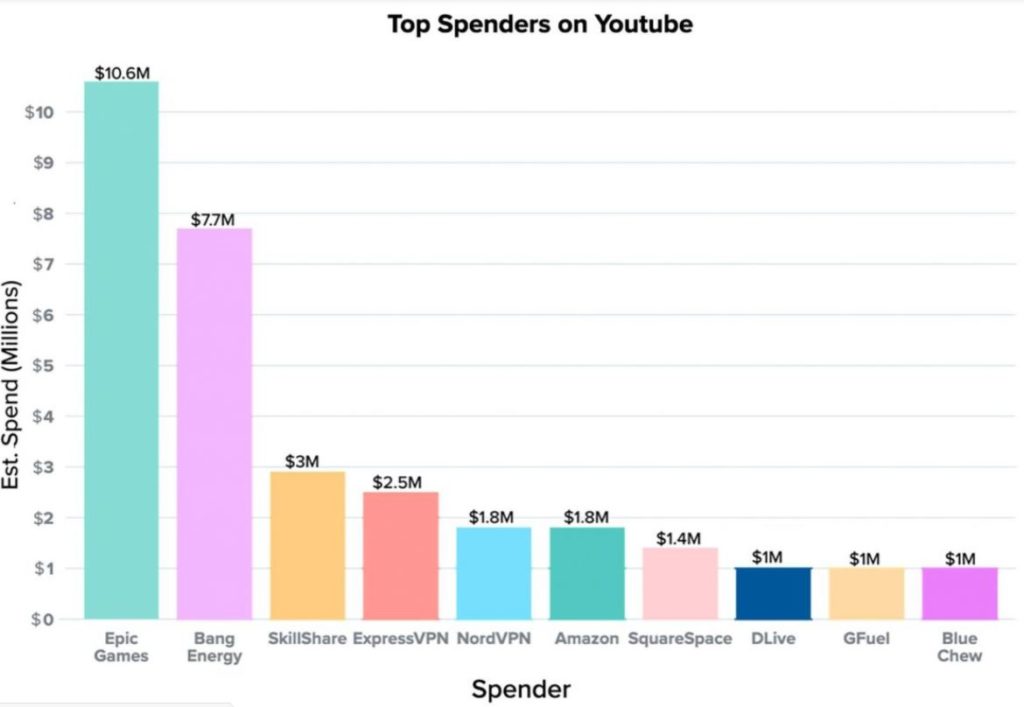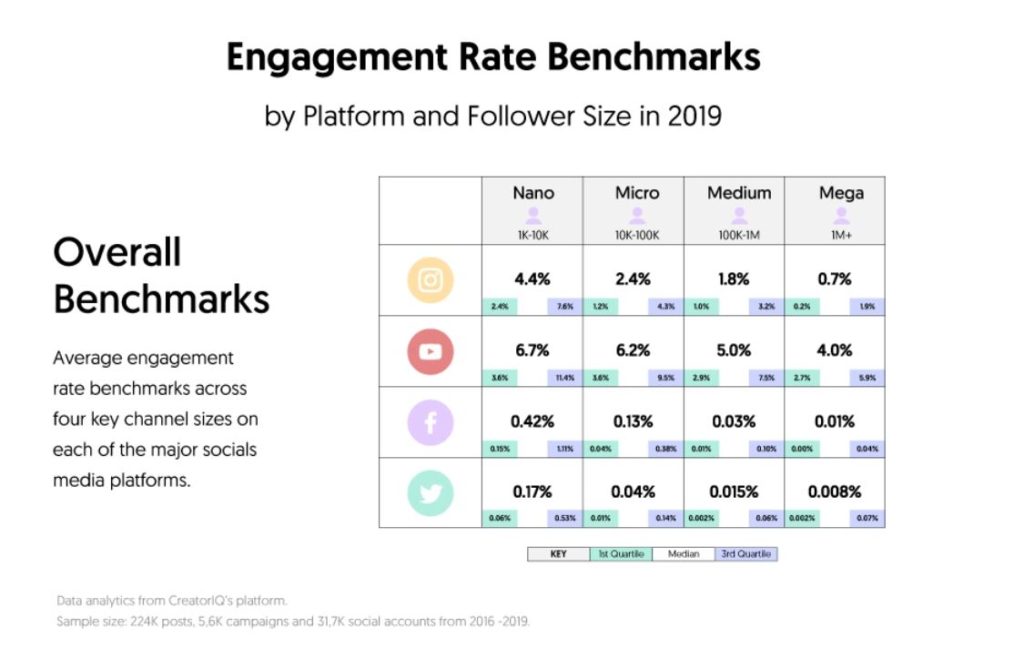As brand influencers become more plentiful and proven, so too will their ability to call for greater industry protections, such as inclusivity-linked fairer pay, formal contracts, and the ability to unionise.
The influencer marketing industry is on track to be worth up to $15 billion by 2022, up from as much as $8 billion in 2019, according to Business Insider Intelligence estimates, based on Mediakix data.
Every social platform attracts influencers to some degree, but Instagram is the gold standard for the group, according to another report by Influencer Marketing Hub. Nearly four in five (79%) brands predominantly tap Instagram for influencer campaigns, compared with Facebook (46%), YouTube (36%), Twitter (24%), and LinkedIn (12%).
The sectors that are associated with the greatest use of brand influencers and sponsored content are Gaming, Tech, Food & Drink, Beauty, Fashion, Travel, Education, Fitness, Automotive, and Health & Wellness. The companies with the biggest sponsored YouTube spend can be found in the chart below.

Source: Influencer Marketing Hub
Youtube Influencer Marketing Global Spend Report: Q1, 2020
Celebrities taking a back seat
According to the US Small Business Administration, small businesses comprise 99.9% of all U.S. corporations. From nano to mega, social media influencers of varying reach are rarely recognized as American small business owners, even though their entrepreneurial stewardship fuels the launch of their own product lines and innovative digital ventures. Influencers are stimulating local economies and creating jobs across the country, but they are not getting the credit they deserve.
From teens to mothers, the majority of today’s online customers have more faith in a micro influencer’s product endorsement than that of a celebrity’s. There has been an incremental rise in nano and micro-influencers- those that have 50,000 or less followers – attracting prospective work from brands to reach their target customers.
The trend at this smaller end of the Influencer spectrum was spurred along during the pandemic and subsequent lockdown measures. In addition to Instagram followers seeing a newfound group of followers during this period, so too did those on TikTok, the social media app that allows users to watch, create, and share 15-second videos shot on mobile phones. India banned Tik Tok this summer and the China-developed app’s user tracking caused privacy concerns, which nearly garnered the US a domestic ban in the US.
That scenario has made a U-turn with Oracle and Walmart set to make a massive deal with the parent company, ByteDance, which is looking to IPO its global TikTok operations on a US stock exchange. At the time of writing, news channel, CNBC, reported that US President Donald Trump would be deciding on the deal’s fate within days. Data security experts have expressed on the business news channel that too many questions remain as to where the Tik Tok data will end up with Oracle holding just a 20% stake? If the algorithms can be seen on the US site, yet the user data is still going to Beijing, regardless of Oracle working with a “trusted technology partner”, why would Trump give the deal the green light?
Instagram reigns
The marketing and branding services of micro-influencers whether on Tik Tok or Instagram cost a fraction of those demanded by a globally known macro-influencer or celebrity and micro-influencers can have a more engaged relationship with their followers because of the smaller ‘community’ size. The most common measure of influencer marketing success is now conversions/sales, according to Influencer Marketing Hub.

Statistics highlight how “pitiful” the engagement rates can be for mega-influencers, particularly on Twitter (with just 0.008% engagement and Facebook (0.01% engagement), said the report. Even nano-influencers struggle to make much headway on these two platforms, (0.17% Twitter, 0.42% Facebook), so it is clear why so many brands prefer to use Instagram for their influencer marketing.
Time to unionise?
Regardless of community size, influencers are starting to share their agency and brand work experiences, and when they find out that they are seriously underpaid compared to their fellow influencers they start to wonder why.
Are they not in on a secret? Just a bad negotiator? Is the lack of formal contracts the crux of the issue? Or are there discriminatory practices, such as gender or race wage disparity widely to blame?
It is hard to assess what the answer or answers might be without analysing on a case by case basis. However, pay rates are a taboo subject in any industry, but especially so for freelancers or short-term contract workers. However, creating a platform for greater pay transparency through the use of formal contracts is one way to get answers. At least that is the plan for a group of British fashion Instagrammers.
The Creator Union’s (TCU), based in the UK, is the first union for influencers, in response to what has been called by Vogue Business as a reckoning of discriminatory practices that include wage disparity. The issue recently raised by an anonymous Instagram account @InfluencerPayGap as well as a lack of diversity in campaigns, formal contracts, and safeguards to ensure fair content usage.
The Creator’s Union will represent workers in the Influencer, Blogger & Digital Content Creator space and work to ensure they have proper protections in place as the influencer marketing industry matures.
Co-founders, Kat Molesworth and Nicole Ocran join the likes of the American Influencer Council, an invite-only, not-for-profit trade association launched by Qianna Smith Bruneteau in June alongside a founding group of 12 influencers organising to create a fairer global industry. Smith Bruntea was the 10th Annual Shorty Award winner for ‘Best Celebrity/Influencer Campaign on Snapchat,’ and 3rd Annual Social Good Shorty Award winner for ‘Best Use of Live-streaming Video
The AIC is uniting the most prominent US-based social media influencers. The Council claims it is not only a community, but also a “think-tank of digital entrepreneurs” who are fuelling the creative, the storylines and the success behind the multi-billion dollar influencer marketing industry in America.
“Creativity doesn’t sleep,” says Aliza Licht, AIC Board Co-Vice President and early social media maverick as the former Twitter personality DKNY PR GIRL.
“In the past decade, social media has transformed the way the world communicates and consumes information in every industry. Influencers are leading this revolution, and our goal is to empower our members with the resources they need to stay on the pulse of the ever-changing issues, trends and legislation that impact the influencer marketing industry in the US,” says Licht.
Like most trade associations, the AIC will strive to establish the standards necessary to improve and/or promote those working professionals in the Influencer Marketing industry. Similar to a networking medium, trade associations can provide a forum in which members can caucus on issues that affect shared interests. Trade associations are comprised of different sill sets businesses that operate in the field that can then collaborate to lobby the government and establish alignment between the businesses to protect and exalt the name and image of the industry in question. This is where the freelancer community can become active as they bring their clients and businesses into the Influencer Marketing sector.
Unlike a union, the AIC cannot lobby for wage standards. “However, we recognize that awareness is an agent for change,” an AIC spokesperson tells Freelance Informer via email.
“Public Goodwill and promoting our trade is one of our mission pillars. We will be having conversations that draw attention to industry facts. As an example, YouTube creators earn on average $10k a year and that’s only if you have a channel with 1M subscribers,” says the spokesperson.
The AIC will bring attention to the trade issues that prevent the acceleration of creator business growth. For example, Instagram turns 10 in October. Only in May did the company announce a creator revenue share programme that so far only 200 creators have been approved for in the US, according to the AIC.

Influencers: know your worth
According to influencer platforms, such as BrandBacker, which has a database of 20,000 micro-influencers, the brands that come up with a proposal to influencers, not the other way around, e.g. free product, discounts, early access to something, or an amount of payment, maybe as little as $20-$30 per post.
Those influencers who want to be part of a campaign apply. The brand then selects who they want to work with. While a company will pay a subscription fee to be a member of BrandBacker and similar types of platforms, the overall cost is still substantially cheaper than paying celebrities or macro-influencers huge fees, according to Influencer Marketing Hub.
If you are an influencer and you get positive feedback from the client ask what their ROI was by contracting your services. Ask for the sales conversions. This is a nuggets of information you can use a a negotiating tactic on your next campaign.
A year ago, the focus on influencer marketing measurement was relatively evenly balanced between differing campaign goals, but Conversion/Sales was the least-supported reason. This year, it has a clear, undisputed lead, according to Influencer Marketing Hub research.
Ready to join the Influencer Sector?
“Social media and influencers continue to reinvent the communication landscape for businesses not only in the US, but globally,” according to Chriselle Lim, the Founding Chairwoman of AIC, a pioneer of the fashion blog movement and owner of two startups.
“I am a personal brand and a product developer managing two companies. Small businesses including creators are an anchor of the U.S. economy. The mission-critical work in motion at the AIC is only going to strengthen and further legitimize the efforts of the creator community in America. I’m honored to chair this endeavor,” says Lim.
Whether you are a small business looking to grow your sales through a brand influencer or you want to become an influencer by showcasing your expertise or passion, there are plenty of marketing-focused platforms and agencies to choose from. A total of 380 in 2019, up from 190 in 2015. In a report conducted by CreatorIQ, it found that there has been a clear increase in the average number of creators activated per organization. Numbers nearly doubled from 320 in 2017 to 600 in 2018, and have continued to rise (albeit at a slower rate) to 660 in 2019.
According to the report’s respondents, 44% currently use tools developed in-house to execute influencer marketing campaigns, and 40% use 3rd-party influencer marketing platforms. This stat could suggest that the influencer platforms need to do a better job at marketing their services, which is where freelance Marketing Consultants can find new client opportunities.
The statistics also suggest that many potential customers out there still require assistance at discovering and then reaching out to potential influencers. Whether you want to become your company’s own brand influencer or you want to set up a better Instagram story campaign for a client, here is a video that will show you some tips. Here is also an article by Instagram platform specialist Later that takes you through those Instagram hacks and tips.


